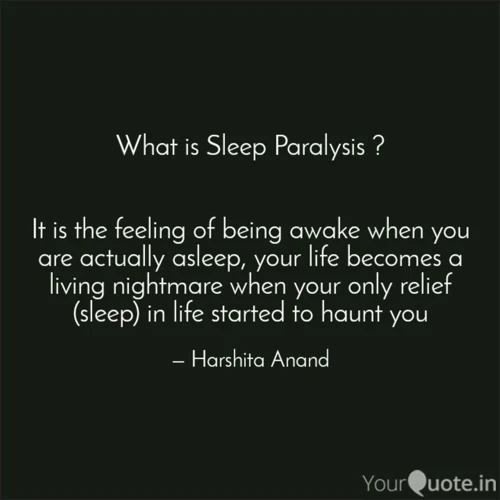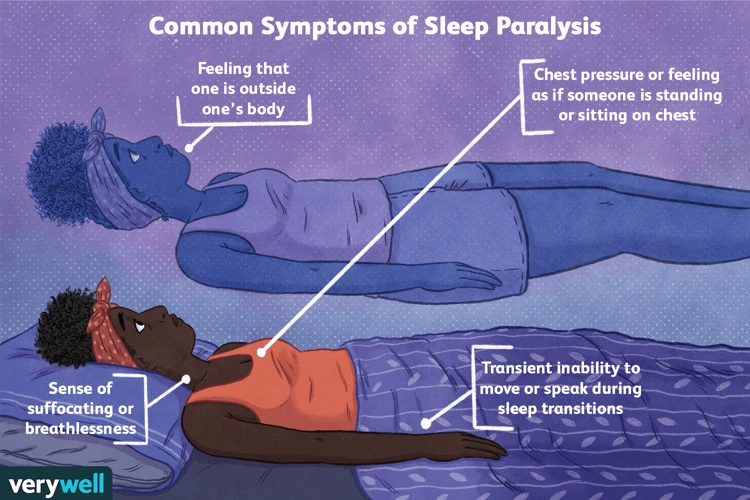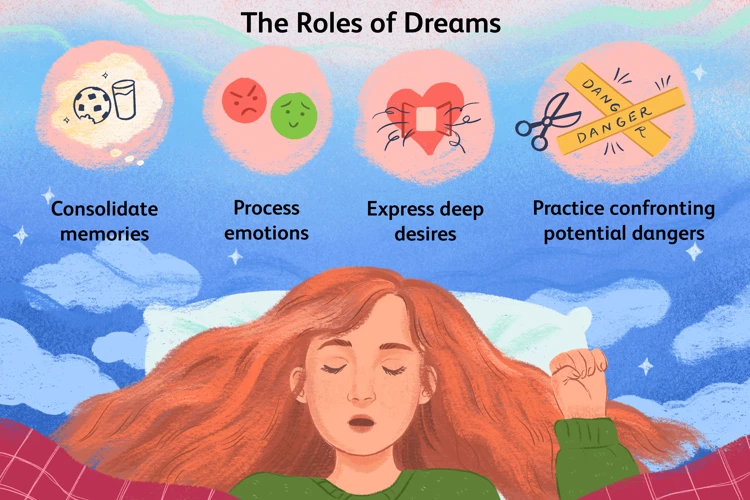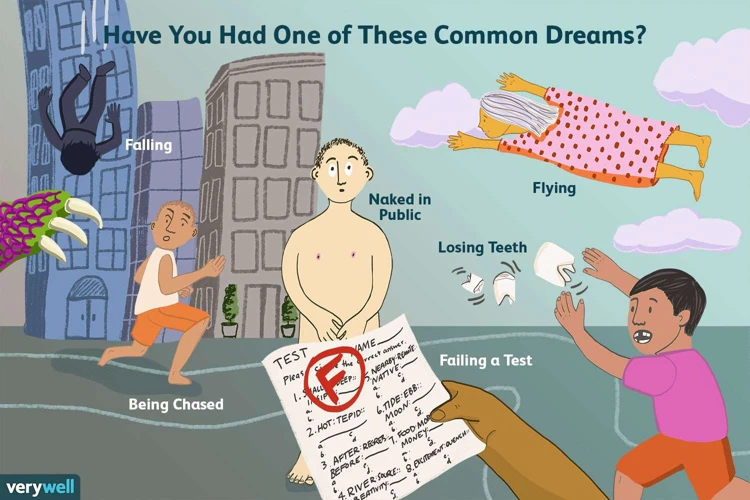Imagine waking up in the middle of the night, unable to move your body, with a strange sense of dread looming over you. This perplexing phenomenon, known as sleep paralysis, has puzzled scientists and haunted individuals for centuries. In this article, we will delve into the science behind sleep paralysis, exploring its definition, prevalence, and cultural perspectives. We will also unravel the intricate processes that occur in our brains during sleep paralysis and examine the psychological explanations behind this enigmatic experience. We will discuss the common symptoms and experiences associated with sleep paralysis and provide practical tips on how to manage and cope with this perplexing condition. So, let us embark on this journey through the mysteries of sleep paralysis and uncover the secrets that lie within the realm of the sleeping mind.
What is Sleep Paralysis?

Sleep Paralysis: a term that elicits a sense of curiosity and intrigue. What exactly is sleep paralysis? In the simplest terms, sleep paralysis is a temporary inability to move or speak that occurs during the transition between sleep and wakefulness. During this bizarre phenomenon, the mind is awake, but the body remains in a state of muscular immobility. Sleep paralysis can last for a few seconds to a few minutes, leaving those who experience it with a mix of fascination and fear. While it may sound like a rare occurrence, sleep paralysis is actually quite common, with studies suggesting that up to 8% of the general population has experienced it at least once in their lifetime. Cultural perspectives on sleep paralysis vary, with some societies attributing it to supernatural forces or even demonic visitations. However, modern science has uncovered the underlying mechanisms behind sleep paralysis, which we will explore in the following sections. To learn more about the connection between sleep paralysis and sleep disorders, click here.
Definition
Definition: Sleep paralysis is a phenomenon characterized by a temporary inability to move or speak while transitioning between sleep and wakefulness. It occurs during two key moments in the sleep cycle: when falling asleep (hypnagogic or predormital sleep paralysis) and when waking up (hypnopompic or postdormital sleep paralysis). During these episodes, individuals typically find themselves consciously awake but unable to move their voluntary muscles. This state can be accompanied by vivid sensory hallucinations and a feeling of pressure on the chest, which can cause distress and fear. Sleep paralysis is believed to occur due to a disruption in the normal transition of sleep stages, particularly during rapid eye movement (REM) sleep. To understand more about the psychological impact of sleep paralysis, you can read our article here.
Prevalence
Sleep paralysis, despite its eerie nature, is surprisingly prevalent. Studies suggest that around 8% of the general population has experienced sleep paralysis at least once in their lives. However, the actual prevalence may be even higher, as many people may not report their experiences due to fear, confusion, or simply not recognizing the phenomenon. It is important to note that sleep paralysis can occur in people of all ages, genders, and cultural backgrounds.
While sleep paralysis can be a one-time occurrence, it can also be a recurrent phenomenon for some individuals. Research has shown that approximately 25% to 30% of those who experience sleep paralysis have recurrent episodes, with some even encountering it multiple times within a single night. The frequency of episodes can vary greatly from person to person, with some experiencing sleep paralysis sporadically throughout their lives and others having it occur more frequently.
Interestingly, several factors have been found to increase the likelihood of experiencing sleep paralysis. These include a history of sleep disorders, such as narcolepsy or insomnia, irregular sleep schedules, sleep deprivation, and high levels of stress and anxiety. It is also worth noting that individuals who regularly have lucid dreams, where they are aware they are dreaming and may have some control over the dream, may have a higher propensity for experiencing sleep paralysis. To further explore the connection between sleep paralysis and lucid dreaming, you can find more information here.
Cultural Perspectives
Cultural Perspectives: Sleep paralysis has long been a subject of fascination in various cultures around the world, each offering its own unique interpretation of this perplexing phenomenon. In many societies, sleep paralysis is intertwined with supernatural beliefs and folklore. For example, in some African and Caribbean folklore, it is associated with the presence of an evil spirit or demon sitting on the chest of the paralyzed individual, causing pressure and suffocation. This concept is known as the “Old Hag” or “Night Hag” in Western cultures. Similarly, in Japanese folklore, sleep paralysis is attributed to a creature called the “kanashibari” which is believed to paralyze its victims during the night.
In addition to supernatural explanations, cultural perspectives on sleep paralysis can also be influenced by religious beliefs. In certain religious traditions, sleep paralysis is seen as a spiritual encounter, interpreted as a visitation or possession by otherworldly beings. For instance, in medieval Europe, sleep paralysis was associated with witchcraft and the presence of demons.
It’s important to note that while cultural perspectives provide intriguing insights, they are not scientific explanations for sleep paralysis. In modern times, the scientific community has unraveled the biological and psychological mechanisms behind this phenomenon, shedding light on the true nature of sleep paralysis. However, the cultural interpretations and folklore surrounding sleep paralysis continue to captivate and mystify individuals across different societies and generations.
How Does Sleep Paralysis Happen?

Sleep Paralysis Happening: Understanding the mechanics behind sleep paralysis requires a closer look at the sleep stages and the role of REM sleep. Our sleep is composed of distinct stages, with each stage serving a different purpose. Rapid Eye Movement (REM) sleep is a crucial stage where dreams occur and the body experiences muscle atonia, also known as REM atonia. REM atonia is a protective mechanism that prevents us from acting out our dreams and injuring ourselves. However, during sleep paralysis, this muscle paralysis continues even as the mind becomes partially awake, resulting in the sensation of being immobilized. This peculiar phenomenon may be attributed to a disruption in the usual transition between REM sleep and wakefulness. The intricate interaction between various brain regions and neurotransmitters plays a significant role in the occurrence of sleep paralysis. The activation of the brain’s pontine tegmentum during REM sleep and the release of neurotransmitters like gamma-aminobutyric acid (GABA) and glycine contribute to the temporary paralysis experienced during sleep paralysis. To dive deeper into the fascinating connection between sleep paralysis and lucid dreaming, check out our article here.
Sleep Stages
Sleep Stages:
Sleep is a complex process that consists of different stages, each with its own distinct patterns of brain activity and physiological changes. There are typically four main stages of sleep: NREM Stage 1, NREM Stage 2, NREM Stage 3, and REM sleep. During NREM Stage 1, which is the transitional stage between wakefulness and sleep, brain activity begins to slow down, and the body starts to relax. In NREM Stage 2, brain waves become slower, and brief bursts of rapid brain activity, known as sleep spindles, may occur. Deep sleep, also known as NREM Stage 3 or slow-wave sleep, is characterized by even slower brain waves and is considered restorative for the body. Finally, REM (Rapid Eye Movement) sleep is the stage of sleep where most dreaming occurs. It is during REM sleep that sleep paralysis frequently happens. REM sleep is characterized by rapid eye movements, increased brain activity, and temporary paralysis of the major voluntary muscles. This stage is crucial for memory consolidation and learning. The sleep cycle typically repeats throughout the night, with each sleep stage lasting for different durations. Understanding these sleep stages is fundamental to comprehending the mechanisms underlying sleep paralysis and its occurrence during REM sleep.
REM Sleep
REM Sleep: REM, or Rapid Eye Movement, is one of the various stages of sleep that our brains cycle through during the night. During REM sleep, our brains become highly active, resembling the wakeful state in many ways. It is during this stage that most dreams occur. REM sleep typically happens about 90 minutes after falling asleep and can last for around 10 minutes in the first cycle, gradually increasing in duration throughout the night. The characteristics of REM sleep include rapid eye movements (hence the name), increased brain activity, heightened brain metabolism, and muscle atonia (temporary paralysis of voluntary muscles). This muscle paralysis during REM sleep is a natural protective mechanism that prevents us from physically acting out our dreams. The transition in and out of REM sleep is regulated by the complex interplay of neurotransmitters and brain regions. Sleep paralysis often occurs when these transitions are disrupted or fragmented, causing a disconnection between the mind and body. To understand more about the fascinating connection between sleep paralysis and lucid dreaming, click here.
REM Atonia
REM Atonia: One of the key factors contributing to sleep paralysis is a phenomenon called REM atonia. REM (Rapid Eye Movement) sleep is a stage of sleep characterized by heightened brain activity and vivid dreaming. During REM sleep, the brain sends signals to inhibit the muscles, effectively immobilizing the body to prevent acting out dreams. This muscle paralysis is known as REM atonia. In this state, the muscles become temporarily inactive, except for the muscles involved in eye movement and breathing. This temporary paralysis is necessary to prevent physically acting out dreams, which could be potentially dangerous. However, when someone experiences sleep paralysis, the atonia persists even as they wake up, leading to the feeling of being trapped in their own body.
The exact mechanisms behind why REM atonia fails to lift during sleep paralysis are still not fully understood. It is believed that disruptions in the normal sleep-wake cycle, such as irregular sleep patterns or sleep deprivation, can contribute to these episodes. Additionally, research suggests that underlying psychological factors, such as anxiety and stress, may also play a role in the occurrence of sleep paralysis.
To summarize, REM atonia is a natural state of muscle paralysis that occurs during REM sleep to prevent us from physically acting out our dreams. When this paralysis continues into wakefulness, it results in sleep paralysis, leaving individuals temporarily unable to move or speak. The next section will delve deeper into the role of the brain in sleep paralysis.
The Role of the Brain

The Role of the Brain: When it comes to sleep paralysis, the brain plays a pivotal role in orchestrating this intriguing phenomenon. To understand how the brain contributes to sleep paralysis, we must first examine the intricate processes that occur during sleep. Our sleep cycle consists of several stages, including non-REM (NREM) sleep and REM sleep. REM sleep, characterized by rapid eye movements, vivid dreaming, and temporary muscle paralysis, is where sleep paralysis primarily occurs. During REM sleep, the brain releases neurotransmitters that inhibit motor neurons, leading to a state of muscle atonia known as REM atonia. This muscle paralysis is a protective mechanism that prevents us from physically acting out our dreams.
Neurotransmitters, such as gamma-aminobutyric acid (GABA), glycine, and serotonin, play crucial roles in regulating the transition between wakefulness and sleep, as well as maintaining REM atonia. Changes in the activity of these neurotransmitters can disrupt the delicate balance required for smooth transitions during sleep, potentially leading to instances of sleep paralysis. When it comes to brain activity, research has shown that individuals experiencing sleep paralysis often exhibit increased activity in the amygdala, which is responsible for processing emotions and fear responses. This hyperactivity may explain the intense sensations of fear and the presence of hallucinations during sleep paralysis.
Understanding the intricate interplay between neurotransmitters, brain activity, and the sleep cycle brings us closer to unraveling the mystery of sleep paralysis. The topic of psychological explanations for sleep paralysis will be explored further in the following section. To learn more about the impact of sleep paralysis on psychological well-being, click here.
Neurotransmitters
Neurotransmitters: these chemical messengers play a critical role in the occurrence of sleep paralysis. The intricate dance of neurotransmitters in our brains influences various functions, including sleep and wakefulness. During normal sleep, the brain releases inhibitory neurotransmitters, such as gamma-aminobutyric acid (GABA), which help to suppress signals from the brain that can trigger movement. This suppression of muscle activity is important to prevent us from physically acting out our dreams during Rapid Eye Movement (REM) sleep. However, in the case of sleep paralysis, there seems to be a disruption in the balance of neurotransmitters. Research suggests that certain neurotransmitters, like dopamine and serotonin, may be involved in the occurrence of sleep paralysis. These neurotransmitters play a role in regulating sleep, mood, and emotions. Altered levels or dysregulation of neurotransmitters during the sleep-wake transition can lead to the temporary paralysis experienced during sleep paralysis. To gain a better understanding of the psychological impact of sleep paralysis, you can read about it here.
Changes in Brain Activity
Changes in Brain Activity: Understanding the brain’s role in sleep paralysis is key to unraveling its mysteries. When we enter the REM (Rapid Eye Movement) stage of sleep, our brain becomes highly active, almost resembling the activity levels during wakefulness. However, during REM sleep, a fascinating phenomenon called REM atonia occurs, which is the inhibition of most voluntary muscle activity. This mechanism prevents us from acting out our dreams and potentially harming ourselves or others. In the case of sleep paralysis, this mechanism is disrupted, resulting in a unique state where the mind is conscious, but the body remains paralyzed. Studies using imaging techniques have revealed notable changes in brain activity during sleep paralysis. These studies have observed increased activity in the amygdala, a region associated with fear and emotions, as well as reduced activity in the prefrontal cortex, which is responsible for logical thinking and decision-making. These alterations in brain activity contribute to the vivid hallucinations and intense emotions often experienced during sleep paralysis. For more information on the psychological impact of sleep paralysis, click here.
Psychological Explanations

Psychological Explanations: While the phenomenon of sleep paralysis has long been associated with supernatural beliefs and folklore, modern science has shed light on the psychological factors that contribute to its occurrence. One prominent explanation for sleep paralysis is the influence of stress and anxiety. It is believed that high levels of stress can disrupt the normal sleep cycle, leading to an increased likelihood of experiencing sleep paralysis. Additionally, individuals with certain sleep disorders, such as narcolepsy, are more prone to episodes of sleep paralysis. Another psychological explanation for sleep paralysis is the connection between sleep paralysis and other mental health conditions, such as anxiety disorders and depression. Research indicates that individuals with these conditions have a higher prevalence of sleep paralysis episodes. The intricate relationship between psychological well-being and sleep paralysis is still being explored, but it is clear that our mental state plays a significant role in the occurrence of this perplexing phenomenon. To discover more about the psychological impact of sleep paralysis, click here.
Stress and Anxiety
Stress and Anxiety: In the realm of psychological explanations for sleep paralysis, stress and anxiety play a significant role. It has been observed that individuals who experience high levels of stress or anxiety are more prone to sleep paralysis episodes. Stress can disrupt the normal sleep cycle, leading to fragmented sleep and an increased likelihood of sleep paralysis. Anxiety, on the other hand, can heighten the body’s state of alertness, making it difficult for the mind to transition smoothly between sleep and wakefulness. The physiological response to stress and anxiety involves the release of stress hormones, such as cortisol, which can disrupt the balance of neurotransmitters in the brain. This imbalance may contribute to the occurrence of sleep paralysis. Additionally, the fear and anxiety experienced during sleep paralysis episodes can further perpetuate the cycle, creating a vicious cycle of stress, anxiety, and sleep paralysis. To learn more about the impact of sleep paralysis on psychological well-being, check out our article on psychological sleep paralysis impact.
Sleep Disorders
Sleep Disorders:
Sleep paralysis is often associated with various sleep disorders. One common sleep disorder that can give rise to sleep paralysis is narcolepsy. Narcolepsy is a neurological condition characterized by excessive daytime sleepiness and sudden brief episodes of uncontrollable sleep. People with narcolepsy often experience sleep paralysis as they transition between wakefulness and sleep. Another sleep disorder linked to sleep paralysis is sleep apnea. Sleep apnea is a condition in which a person’s breathing repeatedly stops and starts during sleep, leading to disruptions in the sleep cycle. These disruptions can contribute to the occurrence of sleep paralysis. Additionally, insomnia, a sleep disorder characterized by difficulty falling asleep or staying asleep, has also been associated with sleep paralysis. The relationship between sleep paralysis and these sleep disorders is complex and not yet fully understood, but it highlights the significance of seeking professional help to address underlying sleep issues. To explore more about the psychological impact of sleep paralysis, read our article here.
Common Symptoms and Experiences

Common Symptoms and Experiences: Sleep paralysis is a bewildering phenomenon that often comes with a range of unsettling symptoms and experiences. One of the most common symptoms during sleep paralysis is the occurrence of sensory hallucinations. People may perceive vivid and lifelike sensory experiences, such as hearing footsteps, whispers, or eerie voices, seeing shadowy figures, or feeling a presence in the room. These hallucinations can be incredibly realistic and can intensify feelings of fear and dread. Another common symptom is the sensation of pressure on the chest or body. Many individuals report feeling as if an immense weight is pressing down on them, making it difficult to breathe or move. This feeling of pressure can be distressing and contribute to the overall sense of helplessness during sleep paralysis. It is important to note that while these symptoms can be distressing, they are generally harmless and not indicative of any underlying medical condition. Understanding and recognizing these symptoms can provide reassurance to individuals who experience sleep paralysis.
Sensory Hallucinations
Sensory Hallucinations: One of the most haunting and vivid experiences associated with sleep paralysis is sensory hallucinations. These hallucinations can be both visual and auditory, creating a surreal and sometimes terrifying environment for those who experience them. Visual hallucinations during sleep paralysis often involve seeing shadowy figures, monsters, or even supernatural entities lurking in the room. These hallucinations can feel incredibly real, adding to the fear and confusion experienced during sleep paralysis. Auditory hallucinations, on the other hand, involve hearing strange noises, whispers, or even human voices. These auditory illusions can further intensify the feeling of unease and create an eerie atmosphere. It is important to note that these hallucinations are entirely within the realm of the mind and not based on external stimuli. While sensory hallucinations during sleep paralysis can be unsettling, they are a result of the brain’s intricate and complex processes. To delve deeper into the psychological impact of sleep paralysis, check out our article on the psychological implications of sleep paralysis.
Feeling of Pressure
The feeling of pressure is one of the most commonly reported experiences during sleep paralysis, adding to the sense of unease and terror that often accompanies this phenomenon. Many individuals describe a heavy weight or pressure on their chest, as if an invisible force is pressing down on them, making it difficult to breathe or move. This sensation of pressure can be quite distressing and may contribute to the intense fear and panic often associated with sleep paralysis. While the cause of this perception is not fully understood, it is believed to be a result of the body’s transition between sleep and wakefulness. During sleep paralysis, the brain remains in a semi-dream state, where the body’s voluntary muscle activity is inhibited. This state of REM atonia prevents us from physically acting out our dreams and potentially injuring ourselves. However, the feeling of pressure may arise from a mismatch between the brain’s expectation of muscular control and the actual state of temporary paralysis. This heightened awareness coupled with the inability to move can create a startling and disconcerting experience. While the feeling of pressure during sleep paralysis may be distressing, it is important to remember that it is a transient and harmless phenomenon. Understanding the scientific mechanisms behind these sensations can provide reassurance and help manage the fear associated with sleep paralysis.
How to Manage Sleep Paralysis
Managing Sleep Paralysis: Dealing with sleep paralysis can be a challenging experience, but there are strategies that can help alleviate its impact on your sleep and well-being. Here are some tips on how to manage sleep paralysis:
1. Sleep Hygiene: Maintaining good sleep habits can minimize the likelihood of experiencing sleep paralysis. Ensure you have a consistent sleep schedule, create a relaxing sleep environment, and avoid stimulating activities before bedtime. Practicing relaxation techniques, such as deep breathing or meditation, may also promote better sleep quality.
2. Seeking Professional Help: If sleep paralysis becomes recurrent or significantly affects your quality of life, it is advisable to seek professional help. Sleep specialists or therapists can provide guidance and support in managing sleep disorders or underlying psychological factors that may contribute to sleep paralysis.
3. Understanding Triggers: Reflecting on potential triggers for sleep paralysis episodes may offer insights into managing future occurrences. Factors such as stress, anxiety, disrupted sleep patterns, or sleep deprivation can contribute to increased vulnerability to sleep paralysis. Identifying and addressing these triggers can be beneficial in reducing the frequency and intensity of episodes.
4. Lucid Dreaming Techniques: Some individuals have found success in incorporating lucid dreaming techniques as a means of managing sleep paralysis. Lucid dreaming involves becoming aware that you are dreaming during a dream. By developing the ability to control and manipulate dreams, individuals may have a greater sense of control during sleep paralysis episodes.
5. Talking About It: Sharing your experiences with trusted individuals or participating in support groups can help alleviate the emotional distress often associated with sleep paralysis. Speaking openly about your encounters with sleep paralysis can provide validation, reassurance, and a sense of community with others who have gone through similar experiences.
Remember, every individual’s experience with sleep paralysis is unique, and not all strategies may work for everyone. It’s important to find what works best for you and to prioritize self-care and well-being.
Sleep Hygiene
Sleep Hygiene: We all know that a good night’s sleep is essential for our overall well-being. When it comes to managing sleep paralysis, adopting healthy sleep habits can make a significant difference. This is where sleep hygiene comes into play. Sleep hygiene refers to a set of practices and habits that promote quality sleep and can help minimize the occurrence of sleep paralysis episodes. Firstly, maintaining a consistent sleep schedule is crucial. Going to bed and waking up at the same time each day helps regulate your body’s internal clock and promotes a more regular sleep pattern. Creating a calming bedtime routine can also signal to your body that it’s time to sleep. This can include activities such as reading a book, taking a warm bath, or practicing relaxation techniques. It is important to create a sleep-friendly environment, with a cool, dark, and quiet bedroom. Avoiding stimulating activities or substances before bed is vital, such as avoiding caffeine, nicotine, and electronic screens. Regular exercise can also improve sleep quality and reduce stress levels. To learn more about coping mechanisms and the importance of seeking professional help, click here.
Seeking Professional Help
Seeking Professional Help: If you find yourself regularly experiencing sleep paralysis or if it is causing significant distress in your life, it may be beneficial to seek professional help. Consulting with a healthcare provider, such as a doctor or a sleep specialist, can provide valuable insights and guidance in managing sleep paralysis. These professionals can evaluate your overall sleep health, discuss any potential underlying sleep disorders that may be contributing to the occurrences of sleep paralysis, and develop a personalized treatment plan. They may recommend techniques such as improving sleep hygiene practices, which involve establishing a consistent sleep schedule, creating a calming pre-sleep routine, and optimizing the sleep environment. Additionally, they may suggest cognitive-behavioral therapy (CBT) to address any psychological factors that could be exacerbating sleep paralysis. CBT can help individuals modify negative thought patterns, reduce anxiety and stress, and develop coping mechanisms for dealing with sleep-related issues. Remember, seeking professional help can provide the support and expertise needed to manage sleep paralysis effectively. So, if sleep paralysis is negatively impacting your well-being, don’t hesitate to reach out for assistance.
Conclusion
In conclusion, the enigmatic phenomenon of sleep paralysis continues to captivate both scientists and individuals alike. By understanding the science behind sleep paralysis, we can demystify this perplexing experience and shed light on its underlying mechanisms. Sleep paralysis is a temporary state of muscle immobility that occurs during the transition between sleep and wakefulness. It is a common occurrence, affecting a significant portion of the population. Cultural perspectives on sleep paralysis vary, with some attributing it to supernatural forces. However, scientific research has identified various factors that contribute to sleep paralysis, including sleep stages, REM sleep, and changes in brain activity. Psychological factors such as stress and sleep disorders can also play a role in the occurrence of sleep paralysis. While sleep paralysis can be a frightening experience, understanding its causes and symptoms can help individuals manage and cope with it more effectively. By maintaining good sleep hygiene and seeking professional help when necessary, individuals can minimize the impact of sleep paralysis on their overall well-being. As we delve deeper into the mysteries of the sleeping mind, sleep paralysis will likely continue to spark curiosity and research. Sleep on, and may your dreams be free from the perplexities of sleep paralysis.
Frequently Asked Questions
1. Can anyone experience sleep paralysis?
Yes, sleep paralysis can affect people of all ages and genders. It is a relatively common phenomenon that can occur in individuals who have sleep disorders or those who are otherwise healthy.
2. Is sleep paralysis dangerous?
No, sleep paralysis itself is not dangerous. While the experience can be unsettling and even terrifying, it is generally harmless and does not cause any physical harm.
3. What causes sleep paralysis?
Sleep paralysis can be triggered by various factors, including sleep deprivation, irregular sleep schedules, stress, and sleep disorders such as insomnia or sleep apnea.
4. How long does sleep paralysis last?
The duration of sleep paralysis episodes can vary, but they typically last for a few seconds to a few minutes. However, it can feel much longer to individuals experiencing it due to the intense and vivid nature of the sensations.
5. Can sleep paralysis be prevented?
While it may not be possible to completely prevent sleep paralysis, practicing good sleep hygiene, maintaining a regular sleep schedule, and managing stress levels can reduce the likelihood of experiencing episodes.
6. Are there any treatments for sleep paralysis?
There is no specific treatment for sleep paralysis. However, addressing any underlying sleep disorders, such as insomnia or sleep apnea, through therapy or medication may help reduce the occurrence of sleep paralysis.
7. Can sleep paralysis be mistaken for a paranormal experience?
Yes, sleep paralysis has been associated with various cultural beliefs and mythologies regarding supernatural encounters. It is not uncommon for individuals to interpret their experiences during sleep paralysis as paranormal in nature.
8. Can sleep paralysis lead to other sleep disorders?
While sleep paralysis itself is not considered a sleep disorder, it can be associated with other sleep disorders such as narcolepsy. In some cases, sleep paralysis may coexist with conditions like sleepwalking or sleep-related hallucinations.
9. Are there any ways to break out of sleep paralysis?
If you find yourself experiencing sleep paralysis, try focusing on deep, controlled breaths. Additionally, attempting to move small muscle groups, such as wiggling your fingers or toes, can help disrupt the paralyzed state and transition back to full wakefulness.
10. Are there any links between sleep paralysis and lucid dreaming?
There is a connection between sleep paralysis and lucid dreaming, as both phenomena can occur during the REM (Rapid Eye Movement) stage of sleep. However, not everyone who experiences sleep paralysis has lucid dreams, and vice versa. To learn more about the connection between sleep paralysis and lucid dreaming, click here.








